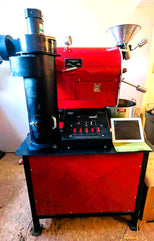
Master the Coffee Roaster Buying Maze With The 3 “P’s”
Are you thinking about getting a coffee roaster? Maybe you want to upgrade your old one, start roasting in your café, or begin your journey as a new roaster. The big question is always the same: Which is the best coffee roaster machine for business?
Buying a roaster is no small step. It costs money, takes planning, and affects how your business runs. With so many choices in size, design, and price, the process can feel like walking through a maze.

The good news is that the maze becomes easier once you know your goals. Who are your customers? How much coffee do you plan to roast? What kind of flavors do you want to create? These answers will guide your choice.
To help you further, we’ve prepared a free guide. It explains roaster types, controls, fuel options, and growth planning; so you can make the smartest decision.
The Three “P’s” of Buying a Coffee Roaster
Buying a new coffee roaster is exciting, but there’s more to think about than just the purchase. To make the most of it, we like to focus on what we call the three P’s:

- Purpose: Why do you need a coffee roaster?
- Protect: How will you take care of it once it’s yours?
- Position: How will you use your instincts to get the best results from it?
Before we go deeper into these three points, here are a few extra tips that may help with planning:
- Replacing your old roaster? Through our CT Connect program, you can sell your current roaster and use that money toward the new one.
- Thinking of buying used? We have a huge collection of second-hand coffee roaster machines and advice on when it makes sense to buy used.
- Need financing? Our Roaster’s Choice Lending Program lets multiple lenders compete, so you get the best loan deal possible.
- Want expert help? If you prefer to talk through these choices with someone, we also offer consulting and training services.
- Still unsure? Check out our FAQs, or reach out directly. We’d love to help you design the coffee roastery of your dreams.
Alright, with those planning tips in mind, let’s go through the first “P”!
P1: Know Your Purpose

Before buying a coffee roaster, the first step is to be clear about your purpose. Ask yourself: Why do I need this roaster?
Some people are new to roasting and want a machine that helps them get started. Others already roast but need a bigger or better model. No matter where you are in the journey, knowing your “why” will guide your choice.
Here are some possible goals to think about:
- Serving fresh coffee in your café.
- Selling bags of coffee in retail stores.
- Supplying hotels, restaurants, or catering businesses.
- Growing an online store for coffee sales.
- Expanding an existing business.
- Offering better quality or more variety to customers.
- Increasing profit and business growth.
Once you know your main purpose, you should ask a few more practical questions with your team:
- Budget: How much can you spend? Will you buy outright or use financing?
- Timing: When do you plan to buy? Remember, permits and inspections can take time. You should start planning 6 to 12 months ahead.
- Customers: Who will you serve, café visitors, wholesale buyers, or both?
- Service style: Will you sell in-person, online, or both?
- Location: Where will the roaster sit? You should check safety rules, space, and ventilation.
- Coffee style: Do you want simple everyday roasts, or do you want to specialize in unique blends or single-origin coffees?
By answering these questions early, you’ll have a clear direction and feel more confident when choosing your roaster.
P2: Protect Your Purchase

After buying a coffee roaster, taking care of it becomes very important. Roasting coffee is a messy process, and running a café or roastery can be busy and chaotic. Roaster protection requires consistency in maintenance and operations. If you look after it, your roaster will last longer and give better results.
Maintenance Tips:
- Follow the manufacturer’s instructions and make a maintenance schedule.
- Let the roaster cool down after each batch.
- Remove chaff (the thin coffee husks) from the drum and under the roaster.
- Clean the main filter weekly or as needed.
- Clean the roasting chamber once a month using a grease-cutting cleaner and a soft scrubbing pad.
- Keep extra spare parts, like belts. Stay ready to avoid interruptions.
Operational Tips:
- Roast enough coffee for the week, perhaps two mornings each week.
- Don’t push the roaster to full capacity all the time; it can affect quality.
- Buy a slightly bigger roaster than you need; it’s easier to grow into it than to replace it quickly.
Workplace Safety and Space:
- Keep safety coffee roaster equipment like first-aid kits, fire extinguishers, eye and ear protection.
- You should plan space for deliveries, storage, and workflow efficiency.
- Ensure your floor, walls, and ceiling can handle the roaster’s weight and venting needs.
- If your café shows the roaster to customers, you should use barriers for safety and reduce noise.
A plan for maintenance, safety, and space safeguards your investment and improves daily operations.
P3: Position Your Instincts

It may sound unusual, but your instincts are very important when buying and using a coffee roaster. As a business owner, you already relied on your gut to start your business. Roasting coffee is both an art and a science, and your instincts guide many important decisions.
Instincts help you decide:
- Which coffee farmers or producers to work with?
- How long to roast each batch?
- What flavors will your customers enjoy?
Even with technology and controls on your roaster, your senses are still the best guide. Coffee roasting is hands-on, and tools should support you. It should not replace your judgment.

Practical ways to use your instincts:
- Taste your coffee often, even daily, to make sure it meets your standards.
- Cup coffee with your staff to explore different flavors and train your palate.
- You should watch for signs that beans are aging or roasting profiles need adjustment.
- Keep your roaster clean and parts working properly to support consistent results.
By paying attention to daily details, you sharpen your instincts. It makes bigger decisions, like choosing a new roaster, much easier and more confident. And remember to enjoy the process. Roasting coffee should be fun as well as rewarding.
Other Factors to Consider While Choosing a Roaster
The right commercial coffee roasting machine involves more than appearance. You need to think carefully about your business, your coffee goals, and your budget to make the best choice.
1. Budget and Priorities
Before you start shopping, you should determine your budget. Write down your needs and wants in order of importance. Conversations with other roasters reveal what is necessary and what is optional. It helps prevent overspending on features you may not use.
2. Capacity and Production Needs
Think about how much coffee you will roast every day or week. A machine too small will slow down production, while one too big can waste energy and space. The right roaster size supports production goals and prevents equipment strain.
3. Automation and User Interface
Some roasters are fully automatic, some are semi-automatic, and some are manual. Automatic roasters make it easier to repeat the same roast every time, while manual roasters give more control for experimenting with flavors. You should choose a style that matches your skills and the level of control you want.
4. Choosing the Roaster Company
The company you buy from matters a lot. You should check their reliability, tech support, and service quality. Make sure they can provide spare parts quickly to avoid long downtime if something breaks. A good company makes owning the roaster much easier.
5. Machine Features and Style
You should look at features like roasting style, energy efficiency, sustainability, and specific model options. Consider the price-to-quality ratio and how consistent the roaster is. Some machines are better for small-batch specialty coffee, others for high-volume commercial use.
6. Space and Efficiency
Plan for the space your roaster needs, including ventilation and workflow. You should ensure there is room for deliveries, storage, and safe movement around the machine. A smooth-running roastery depends on energy efficiency, ergonomics, and safety.
Careful attention to budget, production, automation, reliability, features, and space helps you choose the best coffee roaster for a small business.
End Note
Buying the right coffee roaster can feel tricky, but with careful planning and the three “P’s” - Purpose, Protect, and Position, you can make a confident choice. The best coffee roaster for a small business depends on your budget, production, automation, company reliability, features, and space.
At CoffeeTec, we make it easier to find the perfect roaster for your business. From new and used machines to financing options and expert support, we help you every step of the way. So, start your coffee roasting journey today with CoffeeTec!
FAQs
Should I buy a new or used coffee roaster?+
Both options work. New roasters give a full warranty and the latest features. Used roasters can save money, but check their condition, maintenance history, and spare parts availability.
Can I automate my coffee roasting?+
Yes. Some machines are fully automatic, others semi-automatic or manual. Automation helps keep consistent roasting profiles, while manual control grants more experimentation with flavors.
How do I know which coffee style to roast?+
You should decide based on your target customers and your goals. You can focus on everyday blends, specialty coffee, or single-origin beans. Your roaster choice should match the coffee style you want to produce.


Comments
Leave a comment